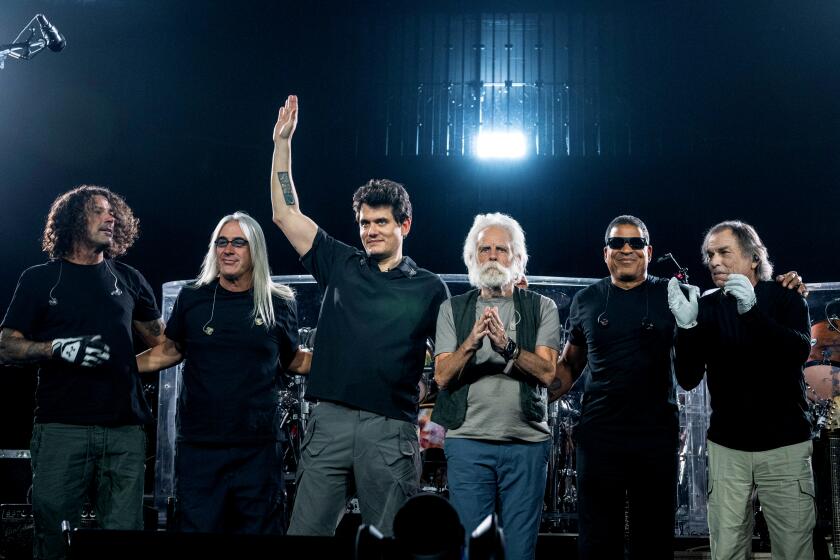It’s the word in rock en espanol
The story of Emilio Morales and Maria Madrigal reads like a rock ‘n’ roll romance.
Morales, a Mexican immigrant and graphic designer, played in one of L.A.’s first rock en espanol bands in the early ‘90s. Madrigal, born and raised in California, was a photographer and Prince fan who had never heard of such a thing as rock in Spanish.
Lured by a black-and-white flier and curiosity, she went to a show at Las Palmas, a Latino nightclub in Anaheim that featured salsa in one room, rock in another. Morales’ band was on the bill, and it was friendship at first sight, even though she started dating his guitarist.
Morales told her he was starting a fanzine for the nascent Latino rock scene. She asked if she could help.
Thus was launched a lasting relationship and a new magazine named La Banda Elastica, both now celebrating their 12th anniversary. Tonight at the Vault 350 in Long Beach, the publishing couple is holding the magazine’s annual awards show with a top lineup of alternative artists from Mexico, Spain, Colombia and the United States.
Started in 1992 as a photocopied newsletter to promote local shows, La Banda Elastica has emerged as a leading journal of the genre, read and respected in alt-Latino capitals throughout the Spanish-speaking world. Many of the best bands in the field aspire to be on the cover of the magazine, published quietly from the couple’s inconspicuous home in West Covina.
“Acts get noticed in La Banda Elastica,” says Tomas Cookman, the North Hollywood-based music executive who has managed top bands such as Chile’s La Ley and Argentina’s Los Fabulosos Cadillacs. “It’s a strong stamp of approval.”
The magazine has made its name internationally through a combination of cutting-edge content and eye-popping graphics. It provides a classy package for a genre that has struggled to gain respect and legitimacy in the music industry.
That the magazine has survived at all is a success. That it survived in L.A. is miraculous.
“It’s been really difficult,” Morales says. “At the beginning, nobody really knew what we were talking about. Advertisers had no idea what kind of music it was or what market it appealed to. There was no information in the Anglo press. Not even La Opinion covered anything.”
Even the fans weren’t there at first.
The magazine was already 4 years old in 1996 when it promoted a concert by acclaimed Mexican singer-songwriter Julieta Venegas, nominated in five of 15 categories tonight.
That solo show at the Dragonfly on Santa Monica Boulevard drew eight people, Morales recalled. The following year, she almost doubled the box office when 15 showed up.
Today, things have changed, for the music and the magazine. Los Angeles is an important alt-Latino market, with top bands touring here regularly. Major U.S. newspapers, in both Spanish and English, routinely cover the scene. And national advertisers are seeking out La Banda Elastica for new ways to reach an important but elusive demographic -- young, hip Latinos.
“Now, people at least have a point of reference,” Morales says. “They know the music exists and that La Banda Elastica covers it. For us, that’s a great accomplishment.”
For two people who are fans of music that is rebellious and often raucous, Morales and Madrigal are both well-mannered, impeccably groomed and soft-spoken to a fault. They are so similar in disposition and tastes that friends warned them their relationship wouldn’t last because they’d get bored.
People said the magazine wouldn’t last either.
They became a couple a year after they met, though they have never married. Morales calls Madrigal “my best friend.” She calls him “my soul mate.”
Their home has been all but overrun by their work, which is their life. Guitar cases, CDs, and Mac computers are everywhere.
The magazine, which claims a bimonthly circulation of 50,000, has satellite offices in cyberspace. Editor Enrique Blanc works from Guadalajara. Correspondents file from Latin America and Spain. And finished layouts for the glossy, 76-page editions are sent electronically to a printer in Santa Fe Springs.
That’s a long way from the 500 copies of Vol. 1, No. 1, printed in July 1992 on a single sheet of paper, folded once to make four pages. The inaugural edition contained a calendar of coming events and a critique of a local band’s demo tape, rated with one to three nopales (cactuses) instead of stars.
A review of what was billed as L.A.’s “first rock en espanol contest,” held in June 1992, lists 24 competing acts, of which only a handful survive, including Maria Fatal, the band Morales was in. The unsigned report, written by Morales, noted that the event drew “only friends of the musicians, or other musicians.” But he went on to declare, defiantly, that “rock en espanol in this paradise of illegals is alive and well and will be hard to stop.”
Morales, 44, now looks back affectionately on the event as “a fiasco.” The venue above a Mexican restaurant in Huntington Park was dreary, the sound system was terrible and the winners never got the promised prizes.
“But everybody was very happy,” Morales says, “because we said, ‘This is great. We’ve really got a scene now.’ ”
The magazine, like the scene itself, has had its ups and downs. Critics say the publishers at times stretched themselves too thin with ancillary activities, displaying more musical passion than management skills.
But it’s passion, the publishers say, that keeps them going.
Despite the music industry’s downturn in recent years, the magazine is planning a long-delayed expansion into Mexico, where the respected daily El Financiero once lamented the lack of good music journalism and singled out La Banda Elastica for praise, asking: “Why must all the well-done rock journalism come from across the border?”
The magazine also has increased domestic revenue by organizing college tours for corporate sponsors, such as Folgers coffee and Always feminine products, and by selling its e-mail list of 30,000 die-hard fans.
Morales, who still writes songs but no longer performs, remains excited about discovering new bands, such as Mexico City’s quirky electronic quintet Austin TV, nominated for best new Latin alternative band in tonight’s competition. The music’s adventurous spirit fuels his hopes for the future.
“I’ve always considered this music as a living organism,” he says. “It’s as if the people themselves somehow sustain it. Over the years, the genre has created enough excitement that people who hear it want to be a part of it.”
And want to spread the word about it.
*
La Banda Elastica 12th Anniversary Concert
Who: El Gran Silencio, Andrea Echeverri, Ely Guerra, Ojos de Brujo, Nino Astronauta
Where: Vault 350, 350 Pine Ave., Long Beach
When: 8 tonight
Price: $45 in advance, $50 at the door
Contact: (888) 808-2858
More to Read
The biggest entertainment stories
Get our big stories about Hollywood, film, television, music, arts, culture and more right in your inbox as soon as they publish.
You may occasionally receive promotional content from the Los Angeles Times.








